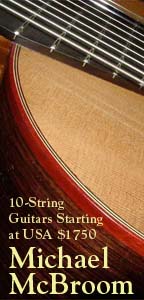































































|
Aug 9 2005, 08:35 PM
OK, it's been a while since I've updated this build,
I know. I was hoping to post all the remaining photos, including
the completion, but things have been delayed again.
I'm using a different french polishing technique on this build
as opposed to my previous guitars. I'm used to being able to
complete the french polish quickly with my old way of doing things.
But when I try to do the same using this new method, I get patches
of dull areas. After discussing this with a friend who's been
building guitars and custom furniture longer than I've been alive,
I've come to the conclusion that I haven't been allowing the
finish to cure fully before attempting to polish it out. So,
now the guitar is hanging on a hook in my shop, and will sit
there for the next week to fully cure. Grrr. New experience for
me. Fortunately Stephen, my client, is a patient soul.
So, anyway, rather than put things off even longer, I thought
I'd show what I'd done since my last post. Here goes.
I finished up on the bridge, installing the tieblock inlay. I
decided to use a strip of the top purfling to tie in the tieblock
theme with the rest of the guitar.
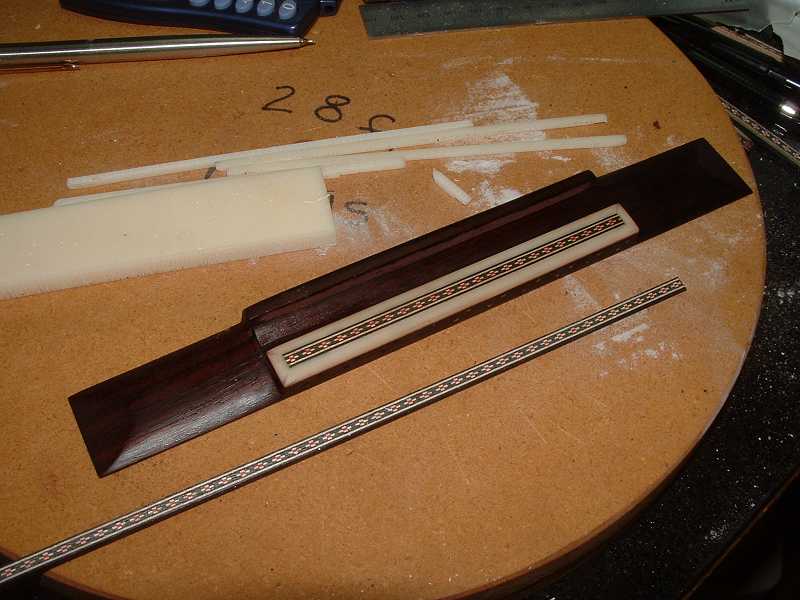
The outer edges of the inlay are a synthetic mammoth ivory material
I bought from Texas Knifemakers Supply. I decided to give this
stuff a try because it was more uniform than the ivory that they
had -- most of it had flaws bad enough across a 5" expanse,
which is what I needed, to render it unusable. Plus this synthetic
ivory is very hard and dense. It's harder than the mammoth ivory
I've used in the past, and while I haven't run any density comparisons
between the two materials yet, my bet is it is even denser than
the mammoth ivory I've bought in the past.
The only thing kinda tricky about using it is I tried mitreing
it the way I mitre wooden purfling -- with a chisel. This stuff
chips when I cut it with a chisel. But that's what I used, because
I figured a saw would be even worse. Next time, though, I'll
give my dovetail saw a try.
Prepped the top for installing the bridge:
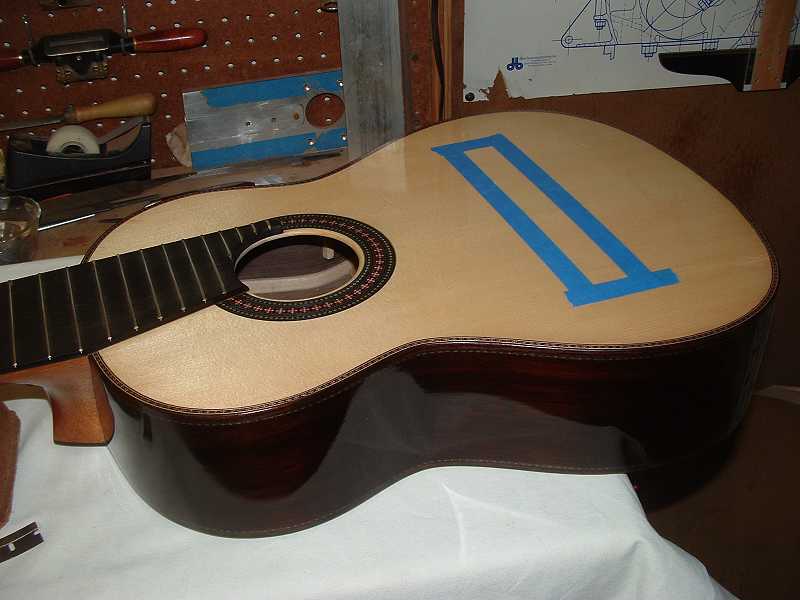
I take careful measurements (shown in a photo below) prior to
laying down the tape. Obviously. For classicals, I use a 1.5mm
(0.060") saddle setback for compensation, along with a nut
set-forward of 0.8mm (1/32").
I lay a long ruler down on the fingerboard at the line that the
high E string will follow, and make sure that the hole for the
E string will coincide exactly with this line. This is an important
step. The high E string needs to be set inboard slightly more
than the low E (well, on a 6-string at least) because the playing
technique of pulling off a note ( a slur downward in pitch),
requires a bit more fingerboard, or else the string will slide
off the fingerboard, making a nasty squelching noise. So. I want
to make sure I have this dimension set up correctly.

Well, strictly speaking, the above comes under the category of
"measure twice, cut once," since I'm laying down the
ruler to double check things after laying down the blue tape.
As does this next photo show. I've already taken the measurements,
but the point here is to double check before I commit myself.
Now, I know I could by a Stewmac Bridge-O-Matic, or whatever
it's called. But why bother?
I butt a machinist square up against the 12th fret and then butt
my rule against the square. I use the 1/100" readout on
this rule. I know already that the width of my fret material
is 0.083". So, the midpoint of the 12th fret is 0.0415"
bridgeward from where the square sits. Which means I add 0.04"
to the measurement from the 12th fret to the saddle centerline.
I add another 0.06" to this dimension for the saddle setback.
This guitar's scale is 660mm, or almost exactly 26". So,
the measurement from the 12th fret to the saddle is 330mm (12.99")
+ 0.04" + 0.06", for a total of 13.09".
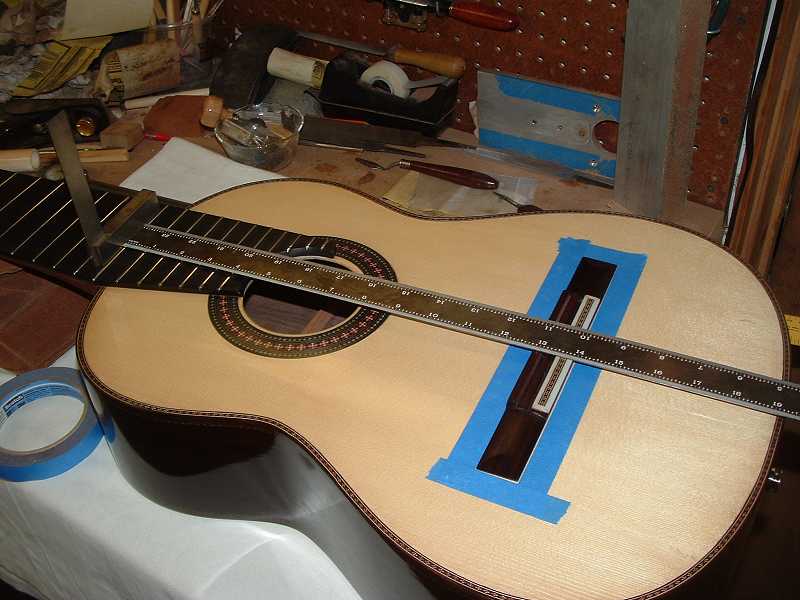
Finally, the moment of truth.
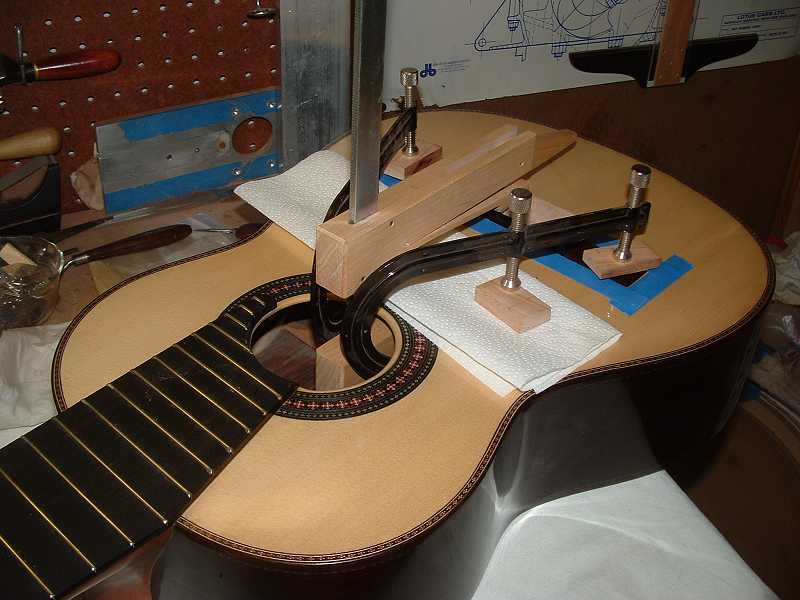
And voila. More or less.
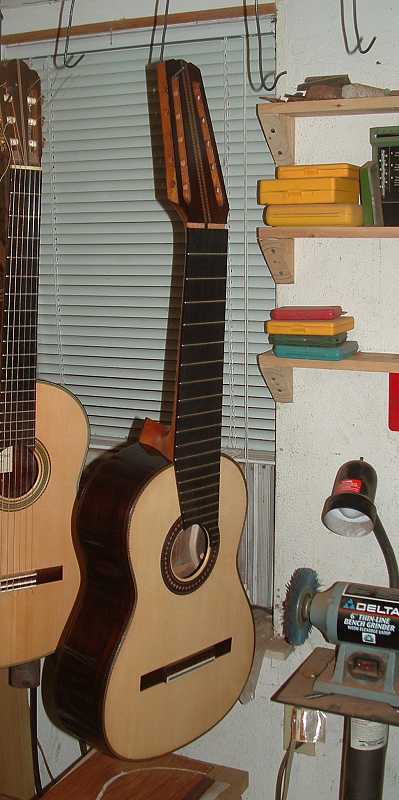
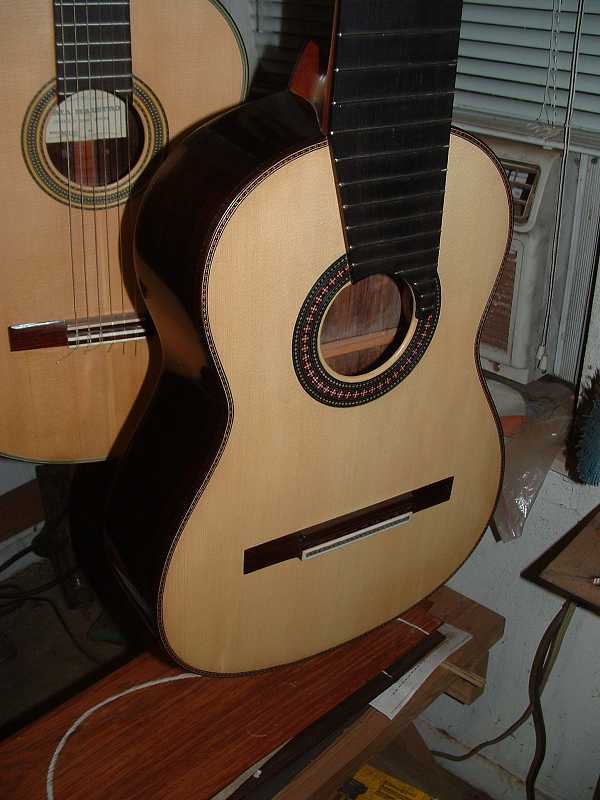
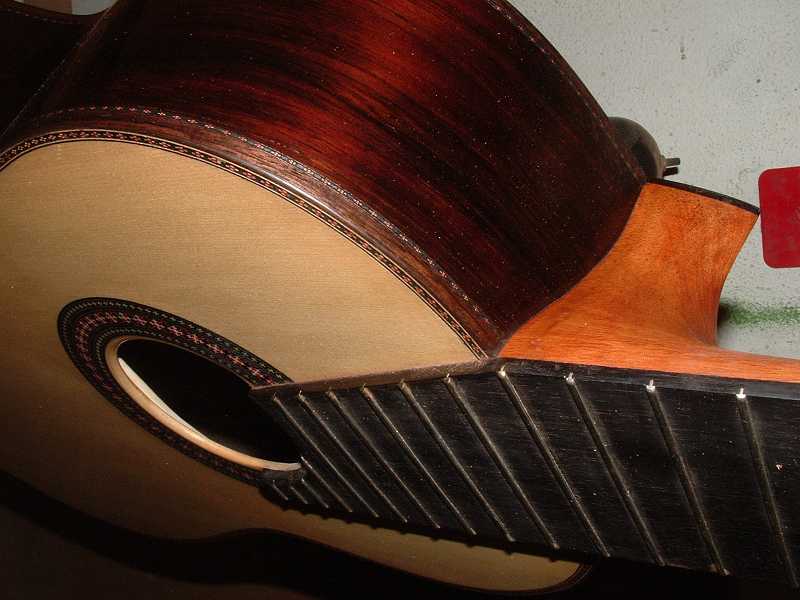

The little white specks you see in the finish are actually reflections.
I tried filling the pores with less than great success. Maybe
better luck next time. So anyway, now I wait for the shellac
to fully cure so I can finish this thing at last.
Believe it or don't as a direct result of the 10-string Festival
I attended last month, I now have two more 10-string builds ahead
of me. I've already started on them. Hope I don't forget how
to build 6-strings.
Best,
Michael
Aug 9 2005, 09:06 PM
Michael, this looks awesome! I am sure you'l get the minor dull
patch problem worked out. Congrats on the 2 new 10-string commissions!
Dennis
Aug 14 2005, 10:05 AM
Nice work Michael:
I am very curious how it will sound. Any chance of posting a
wave file for us to hear when its complete?
David
Aug 14 2005, 11:07 AM
Hi, I'm Stephen Bright, the future owner of McBroom #9. I plan
on picking the guitar up this week, and while down in Houston,
Michael and I will be making a few movies of the sound of #9
compared to #8. Of course, #8 can be already be heard here (scroll
down about 1/2 way):
<http://www.cathedralguitar.com/Perf/index.htm>
We will be posting the new movies at cathedralguitar.com as well.
We'll let you know.
Btw., it was my idea to use the cross motif in the purfling and
the rosette, and when you see the Alessi tuners, the cross motif
appears there as well. My main gig has been playing guitar at
a 19th C. stone cathedral, and the 10-string fills up the space
like no 6-string ever could.
It was also my contention that from a design point of view, today's
classical luthiers are mostly conservative and modernistic when
it comes to the exterior design of the guitar. So I asked Michael
to do this 'purfling run amok' idea to see if it crosses the
line into 'too much.' From the pictures, I think it looks great,
and I can't wait to see it in person.
Stephen
Aug 14 2005, 12:57 PM
Nice job Michael!
I think you have found a market. Stay there.
Steve
Aug 14 2005, 03:10 PM
Thanks, Steve.
Only problem with the 10-string market is it is a tiny
one. Building four 10-strings in a row is very unusual. I figure
that your average master classical builder probably builds maybe
on the order of one 10-string for every hundred 6-strings that
he builds. Maybe that is, at long last, beginning to change,
though.
Best, Michael
Aug 14 2005, 03:13 PM
"IF YOU BUILD IT, THEY WILL COME"
lead
Aug 22 2005, 10:20 PM
Okay, here's the latest, and hopefully concluding post in this
thread -- at least as it pertains to the construction of these
two guitars.
At long last I have strung up number 9.
This event was delayed almost a month because of a different
french polish technique I've been trying to master. I decided
to forsake the relatively quick and easy method Brian Burns taught
me and instead switch over to the more traditional approach as
outlined by Orville and Robert Milburn.
The Milburns' approach did not work out all that well for me.
What I came to find out, after weeks of pulling my hair out over
a few dull spots in the finish was that these dull spots were
due to there not being enough finish in these places. So, purely
out of frustration, I reverted back to the technique I've adapted
from Brian Burns, and whammo, all of a sudden I'm buffing out
the guitar to a nice shine. Grrr. It wasn't a complete waste
of time, however. I did pick up several useful pointers from
the Milburns that I've since incorporated into my old regimen,
and it seems that this combination works best of all.
Okay, so back to the guitar --
Today, I cut the nut and saddle. First, I tried using the synthetic
ivory I used to inlay the tieblock. Simply put, it was awful.
The guitar sounded like a dud -- dull with no volume. I knew
it couldn't be that bad -- not with a Euro spruce top and Brazilian
rw back/sides -- so I yanked those two pieces out, and turned
to this large plank of Corian I have, courtesy of Manitou, one
of the members here. I cut the saddle and nut out of Corian instead,
and wow! What a huge difference it made!
BTW, here are a couple of shots of the finished instrument:
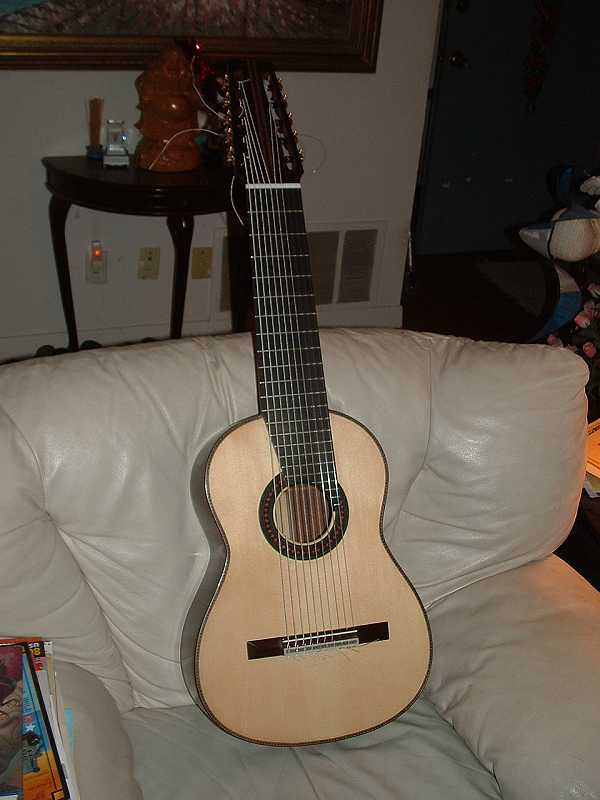
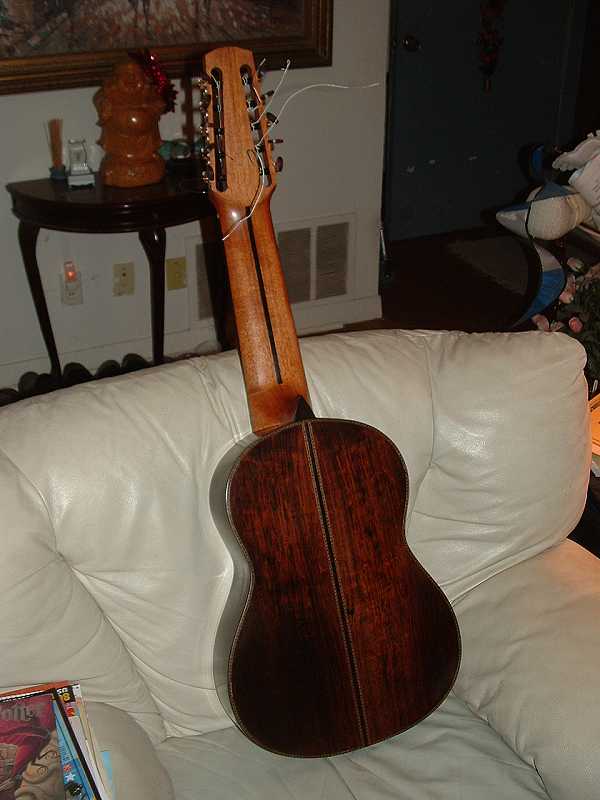
Impressions:
Immediately after stringing it up, it sounded rather tight. Number
8, my first 10 string, is louder -- but then it's been strung
up for a couple months now, and has gotten played quite a bit.
But this guitar has deeper sides, and is more resonant in the
basses -- a good thing with a 10-string.
After it had been strung up for a few hours, it began to settle
in. It sounds louder and the balance has improved. It has a clear
and warm tone -- quite different from number 8.
The top's resonant frequency has dropped from being slightly
sharp of G# down to G. So it's a bit boomy when I hit a G, especially
3rd fret, 6th string. I may try shaving one of the braces and
see if I can drop the pitch just a tad.
Oh, and just as a reminder, this guitar has a pickup. Man-o-man,
it kicks butt through an amp! The basses are positively massive
sounding! I hope Stephen likes it. Cuz it's time to move on.
Got two more 10-strings in the works. I'm thinking about doing
separate threads for each here, if anyone has an interest, mostly
because they're so different. Number 10 is a highly customized
instrument, whereas number 11 will be an entry-level no-frills
model.
Best, Michael
Aug 22 2005, 11:25 PM
Michael and Stephen:
Nice Work! Great Ideas! Thanks for sharing with us.
Dean
Aug 22 2005, 11:34 PM
Michael,
The guitar looks wonderful. What a far cry from ZEN 1 - which
wasn't bad - it's just that this latest 10 string looks great
and we know that inside it looks great too because you showed
us the whole process.
I for one vote for you showing us every build you care to. I
have enjoyed and learned from every one.
So, why is synthetic ivory inferior to corian? Any thoughts?
Steve
Aug 23 2005, 08:55 AM
Steve,
I'm not sure. Even though the synth stuff feels very hard --
it chips easily in fact -- and is pretty dense stuff, I guess
it's sound transmission properties are poor. Texas Knife Supply
has some other stuff I'm interested in trying. They've got knife
handle sets made from camel bone which might be pretty interesting.
About $15/set, and I reckon I can get maybe a half dozen saddles
and three or four nuts (10-string size, that is) out of each
set. Dunno how camel bone compares to cow, but the bone they
use is leg bone, and seems to me that, given a camel's rather
spindly legs and rather large body size, the leg bones might
actually be quite strong.
I don't mind using Corian -- in fact that's all I've used except
for a bone saddle on one of my earlier builds -- but I keep hearing
from others that bone sounds better, so I really want to give
it a try. Problem with cow bone nuts and saddles is I can't find
them in the size I need for 10-strings. And I really don't feel
like getting a big bone and doing all that cutting myself. One
thing I have seen other 10-string builders do is use two-piece
nuts and saddles. Seems to me this might work pretty well.
Best, Michael
Aug 23 2005, 09:00 AM
Michael
Congrats on another beautiful guitar finished, and I look foreward
to the next two.
Charlie
FIRST
PAGE / PAGE 1 / PAGE
2 / PAGE 3 / PAGE
4 / PAGE 5 / PAGE
6 / PAGE 7
|
